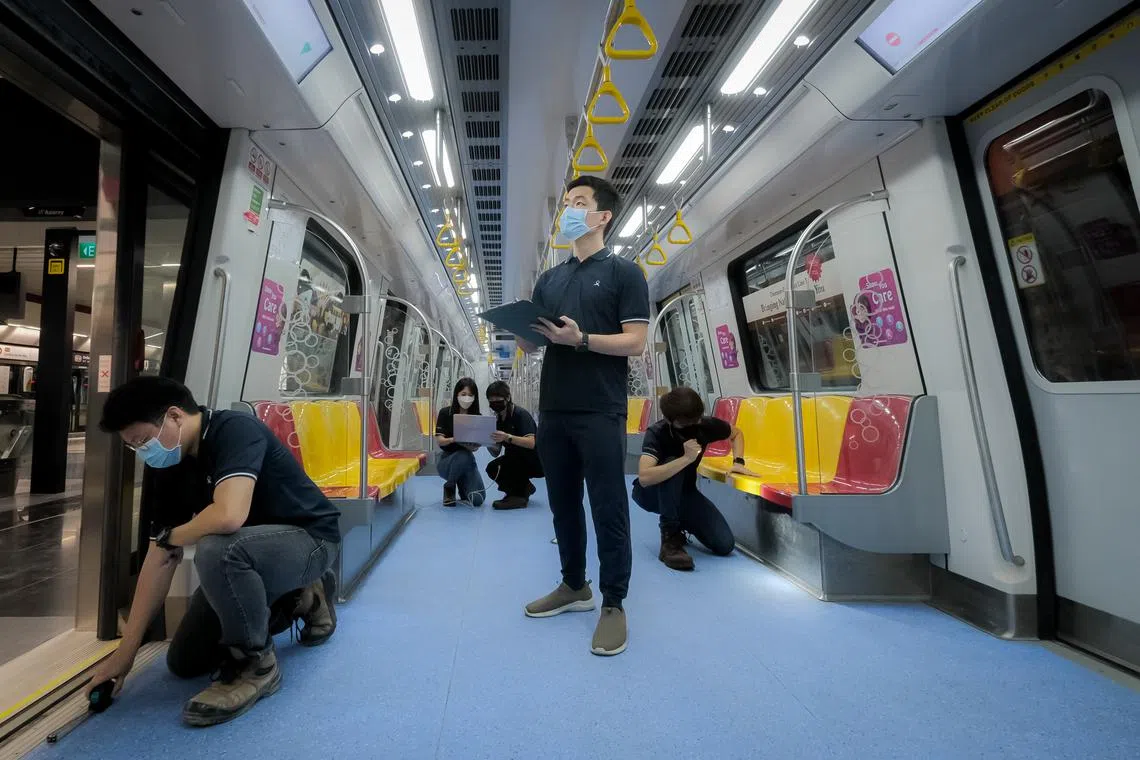Opening of Thomson-East Coast Line Stage 3 to cut off-peak train intervals to 6 minutes
Sign up now: Get ST's newsletters delivered to your inbox

Land Transport Authority project engineers inspecting a train at Napier MRT station on Nov 3, 2022, ahead of the opening of the third stage of the Thomson-East Coast Line.
ST PHOTO: GAVIN FOO
Follow topic:
SINGAPORE - Trains on the Thomson-East Coast Line (TEL) will arrive at stations every six minutes during off-peak hours when the third stage of the rail line opens for passenger service on Nov 13.
This is down from the current interval of nine minutes.
Peak-hour train frequency for the TEL will remain at five minutes, the Land Transport Authority (LTA) said in response to queries. The authority has said that it will review the train frequencies as ridership on the TEL increases.
Trains typically arrive at stations every two to three minutes on other MRT lines during the peak hours of 7am to 9am, and every five to seven minutes during off-peak times.
LTA and rail operator SMRT said they have conducted extensive testing in anticipation of the increased frequency and passenger load for the TEL. Another 11 stations from Stevens to Gardens by the Bay will open on Nov 13, to add to the current nine.
In an interview, LTA group director for rail (electrical and mechanical) Yee Boon Cheow said tests were done using train frequencies higher than what is used for passenger service, to ensure the systems can cope with the increased load.
In August, LTA, SMRT and contractors conducted a two-day stress test involving 180 workers before the 11 TEL Stage 3 (TEL3) stations were handed over to the operator for further operational testing.
SMRT’s managing director for the TEL, Mr Shahrin Abdol Salam, said the operator has validated its operating procedures and processes ahead of the opening.
“In TEL3, we have four stations with stacked platforms, instead of the usual island platforms. Our trial run scenarios were developed and added to sharpen our response in dealing with incidents occurring at the different platforms,” he said.
One issue being ironed out before TEL3 opens is the loud train noise along existing sections of the MRT line that some commuters have complained about.
LTA’s Mr Yee attributed this to uneven train tracks, which are being smoothed out so commuters do not face the same issue when TEL3 begins service.
After TEL2 opened to the public in August 2021,
Asked about this, Mr Yee said noise measurements are part of the tests conducted, but these take an average reading rather than measure “instantaneous noise” at specific points.
“This is something that, for newer lines, we will take into consideration,” he said. “The noise issue for TEL1 and TEL2 is being managed. We know what the issue is... and for certain stretches, we will slow down the train a bit.”
In all, there are about 20 systems that need to be tested after a new MRT line is built, and checks must also be done to ensure these systems – which include the trains, tracks, signalling system and power supply – can work well with one another, said Mr Yee.

An LTA project engineer making sure the train arrives according to schedule at TEL3 Napier MRT Station.
ST PHOTO: GAVIN FOO
For TEL3, the testing of these systems started in earnest around August 2021, after construction of the stations and tunnels was completed. What made testing challenging was that most of it could be conducted only during the limited engineering hours between 12.30am and 4.30am, Mr Yee said.
As other maintenance work also had to be done during these hours, tests could be conducted only three days a week on average, or just 12 hours each week.
The time available was reduced further, as the rail systems had to be reconfigured to include TEL3 before testing could start, and then configured back before passenger service for TEL1 and TEL2 began the next day.
Between February and May 2022, train services on the TEL started later on weekends to carve out additional engineering hours for testing involving running trains along all three stages of the line, from Woodlands North to Gardens by the Bay and back, several times.
More time was needed, Mr Yee said, as one round trip takes about one hour and 45 minutes and the trains need to make at least two round trips for more efficient testing and stability checks.
Covid-19 restrictions did not make testing any easier. “The key challenge with Covid-19 is the uncertainty... It introduces inefficiencies, and adds additional stress,” he added.
One silver lining was that a signalling simulation facility

An LTA project engineer visually inspecting a train for defects on the TEL3.
ST PHOTO: GAVIN FOO
However, despite the simulations, Mr Yee said kinks may still emerge due to the numerous changes being made for TEL3.
“Railway systems are complex. We try as much as possible to catch what we can. But if things happen unexpectedly, we have to deal with it,” he added.
One example of this was a signalling software bug that led to the disruption of morning commutes along the entire TEL for about 3½ hours on July 6.
Mr Yee also said that because the TEL is a new line, some equipment had not gone through what he called the “bathtub curve”, where more failures tend to show up during the initial phase of a new system and at the end of the system’s life, with a stable period in the middle.
While the fourth stage of the TEL is still a couple of years away, some preliminary testing for the seven-station stretch has already started.
Mr Yee said: “We have started to spend more time on testing because expectations are higher now. We really have to make sure the system is ready and reliable before we open.”


